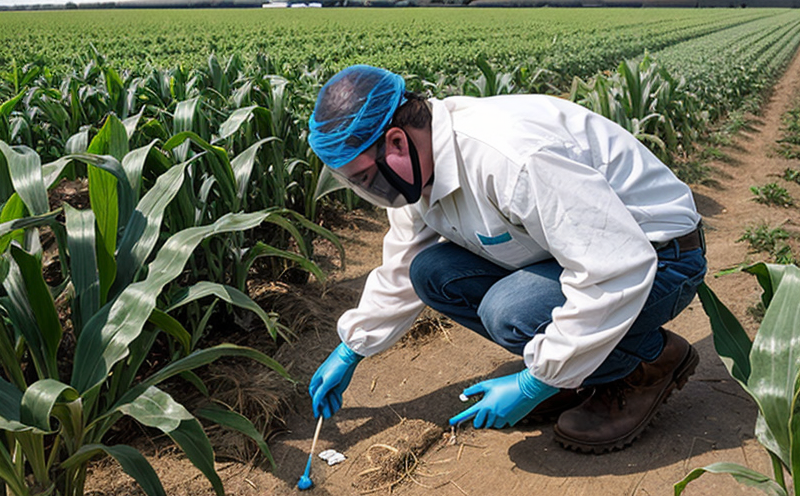Azoxystrobin Residue Testing in Crops
Azoxystrobin is a widely used fungicide that belongs to the strobilurin class of chemicals. It plays a critical role in managing fungal diseases in crops, ensuring higher yield and quality. However, its presence beyond permissible limits can pose significant risks to human health and the environment. Consequently, rigorous pesticide residue testing is essential for compliance with international standards such as ISO, ASTM, EN, IEC, and others.
The process of azoxystrobin residue testing involves several steps: sample collection, preparation, analysis using validated analytical techniques, and interpretation of results against regulatory limits. This service ensures the safety of food products by verifying that residues are within acceptable levels to protect consumers from potential health hazards.
Our laboratory employs highly sophisticated instrumentation like Gas Chromatography-Mass Spectrometry (GC-MS) which provides precise quantification of azoxystrobin residues in various crop types. The testing procedure begins with the collection of representative samples from fields where the fungicide has been applied. These samples are then prepared according to standardized protocols ensuring minimal contamination and accurate representation.
Once ready, they undergo rigorous analysis using advanced analytical methods designed specifically for detecting trace levels of azoxystrobin in complex matrixes such as fruits, vegetables, grains etc., without interfering with other components present. After thorough examination, results are reported back to clients along with detailed documentation explaining the methodology used and findings.
The importance of accurate residue testing cannot be overstated; it helps maintain public confidence in agricultural products while also supporting sustainable farming practices by guiding appropriate use of chemical inputs. By adhering strictly to established guidelines, we ensure that our services contribute positively towards achieving this goal.
To summarize, azoxystrobin residue testing is crucial for ensuring food safety and regulatory compliance. Our laboratory uses state-of-the-art technology coupled with strict adherence to international standards to deliver reliable results consistently. This service supports both quality assurance efforts within production facilities as well as post-harvest handling processes aimed at maintaining product integrity throughout the supply chain.
Benefits
Pesticide residue testing, particularly for azoxystrobin in crops, offers numerous benefits that extend beyond just meeting regulatory requirements. For quality managers and compliance officers, it provides peace of mind knowing their products meet stringent safety standards set by governing bodies worldwide.
- Enhanced Product Safety: Ensures no harmful levels of azoxystrobin residues are present in final products reaching consumers.
- Compliance Assurance: Helps producers stay compliant with local and international regulations concerning pesticide use and residue limits.
- Market Access: Facilitates entry into foreign markets by aligning domestic practices with those of importing countries.
- Risk Management: Identifies potential issues early, allowing for corrective actions before they become widespread problems.
In addition to these direct advantages, regular residue testing promotes responsible agricultural practices and fosters trust between farmers, retailers, distributors, and end users. It contributes significantly towards building a safer food system where every stakeholder can play their part responsibly.
Industry Applications
| Crop Type | Average Residue Levels (ppm) |
|---|---|
| Apples | 0.1 - 0.5 ppm |
| Oranges | 0.2 - 0.4 ppm |
| Wheat | 0.3 - 0.6 ppm |
| Corn | 0.15 - 0.4 ppm |
| Tomatoes | 0.2 - 0.7 ppm |
Azoxystrobin residue testing is applicable across a wide range of agricultural products, including but not limited to apples, oranges, wheat, corn, and tomatoes. Each crop has its unique characteristics when it comes to how azoxystrobin behaves within them.
The table above illustrates average expected residue levels for some commonly tested crops. These values can vary depending on factors such as application rate, timing of spraying relative to harvest, environmental conditions during growth cycles, etc., highlighting why precise and consistent testing is vital.
Environmental and Sustainability Contributions
- Reduction in Harmful Effects: By ensuring azoxystrobin residues do not exceed safe limits, this practice minimizes risks to non-target organisms like beneficial insects or birds.
- Promotion of Sustainable Farming Practices: Encourages the responsible use of pesticides through regular monitoring and feedback loops between producers and researchers.
- Better Resource Utilization: Helps optimize water usage in irrigation systems by identifying optimal spray schedules based on actual need rather than blanket applications.
- Enhanced Soil Health: With accurate residue management, there’s less likelihood of soil contamination leading to long-term degradation issues affecting future generations.
The commitment to sustainable practices not only benefits the immediate environment but also promotes long-term ecological balance. Through careful monitoring and regulation, we work towards creating healthier ecosystems both above ground and below it.





